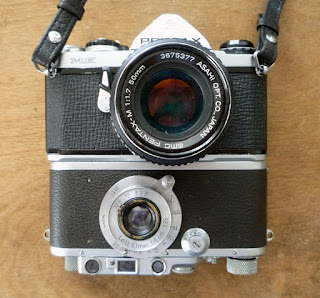While this simplest procedure mostly works, a few glitches can degrade the results. The film rolls onto the take-up reel rather loosely and it can drift sideways, causing some misalignment of the image on the film. An easy fix for that problem is to acquire some 120 to 116 film adapters like the ones sold by the Film Photography Project.
The adapters allow a tight fit of the 120 roll of film into the camera as well as the use of a standard 120 take-up reel. That solves the problem of film misalignment, and the spacers also produce sufficient tautness on the film to help keep the film flat at the film plane. The red adapter disks from the kit can be used alone to hold the film reels, but I found it helpful to insert them into the white holders to facilitate positioning the reels in the camera. The tabs on adapters are a loose fit in the reel slots, so I put a small bit of tape over the tabs to keep them on while inserting them into the camera.I found the small bubble level on ebay for just a few dollars. Since the old folders have no accessory holders I just attached the level to the top deck of the camera with a piece of double-sided tape.
I have not seen any problem with film flatness even without a 120 mask for the film plane. It would be helpful to accurate composition though to make a mask for the viewfinder.
Scanning the long negatives can be a bit of a challenge. My old Epson Perfection 2450 flatbed scanner has a film holder with a 4x5 frame, so I make use of that to hold the negatives in place by placing them directly on the scanner's glass and laying the film holder on top of the film. With the emulsion side of the film toward the glass, the upward curve of the film helps to avoid Newton rings on the scanned images.

















































